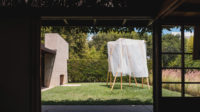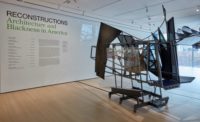Mystical Thinking
This informative and heavily illustrated book is not so much about places where artists have applied principles of Kabbalah—the Jewish mystical interpretation of the universe—but where Alexander Gorlin takes readers to find them. Gorlin, a New York architect and author, uses Kabbalah as a lens for “re-reading . . . art and architecture,” much as critics might interpret art through the filters of class, race, gender, or the Holocaust. The book stems from his fascination with the Kabbalistic idea of genesis expressed as light, space, and geometry, which he sees in many works of modern architecture, sculpture, and painting.

Gorlin clearly describes many of Kabbalah's themes in a manner that speaks to artists and architects. The mystical tradition is concerned with the unseen, but Gorlin focuses mostly on concepts that are expressed in terms of color, light, form, and other visual elements. He uses a language of art and architecture that readers can readily understand—even when we might be surprised to find Kabbalistic references (or echoes) in works we think we know well. Sometimes Gorlin's associations suggest deeper meaning in buildings; at other times his thoughts on buildings clarify Kabbalah obscurities. Many of the works in the book were not intended to be imbued with Jewish mysticism but rely on other mathematical, philosophical, spiritual, aesthetic, and scientific systems. The author maintains, however, that these works embody the essence of Kabbalah, too.
Gorlin immersed himself in Kabbalah when he designed his first synagogue, in Kings Point on Long Island, NY, in 1996. Looking for a structure and narrative to unite function and purpose, he found that Kabbalah “is not only a mystical system of the cosmos, but is a metaphor for the psychology of architectural creation.” Gorlin's recent addition to Louis Kahn's Temple Beth El in Chappaqua, New York, includes explicit Kabbalistic references. Gorlin believes that Kahn's work—with its pure forms and voids and sharp contrasts of light and dark—often refers to ancient Jewish sources. Some contemporary architects invoke Kabbalah in their work too. Steven Holl, for example, says he used it in the lighting design at his St. Ignatius Chapel in Seattle.
The book's 10 chapters are brief essays of historical, descriptive, and analytic text followed by picture galleries. Chapters address Kabbalistic themes such as the ark, tent, and temple; heavenly palaces; the void; and vessels of light, while an epilogue examines the artist Anselm Kiefer, who has addressed the Holocaust in his work. Like Kabbalah itself, Gorlin's book pushes in many directions but remains cohesive.
The author also makes excellent use of captions, filling them with brief but insightful discussions of work by Frank Lloyd Wright, Bruno Taut, Peter Eisenman, Moshe Safdie, Daniel Libeskind, Richard Meier, Coop Himmelb(l)au, and many sculptors and painters.
Samuel D. Gruber is the author of American Synagogues: A Century of Architecture and Jewish Community and writes the blog Samuel Gruber's Jewish Art & Monuments.





Post a comment to this article
Report Abusive Comment